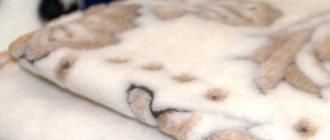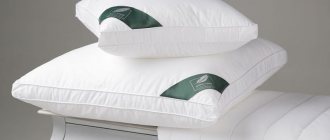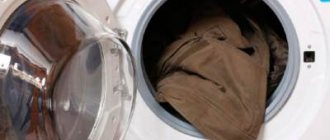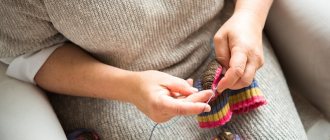For a long time, people have noticed the beneficial properties of sheep wool. They knitted mittens, socks, and clothes from it. A blanket made from such wool is very popular among consumers around the world. It is valued for its thermal qualities, healing effect, lightness and environmental friendliness.
A blanket made of sheep wool, if properly cared for, will last you for several decades, but, like all other things, it tends to get dirty. Such a product requires a special approach, so you cannot simply wash a blanket in a machine without the necessary knowledge.
In this article you can learn how to clean wool blankets without damaging the product itself.
What is special about sheep's wool?
Sheep wool is used in the production of all kinds of materials and things. It has both advantages and small disadvantages.
The advantages of sheep wool include:
- good breathability,
- durability,
- environmental friendliness,
- excellent thermal insulation properties,
- pleasant things to wear.
Unfortunately, this material also has disadvantages. These include:
- high cost of elite types of wool,
- difficulties in care,
- The product must be protected from moths.
Keratin is the main component of sheep wool. It is very durable, allows air to pass through well, but retains heat. The fleece itself is very elastic and resilient, capable of self-cleaning. The main value of sheep wool is its healing properties for health.
Reference! When we wear a sweater made of such material or cover ourselves with a blanket, several effects affect our body: electrostatic, irritating and warming. Those people who have arthritis, radiculitis, diseases of the joints, respiratory tract, and circulatory system will be able to appreciate the healing qualities of wool.
Wool also contains lanolin, which helps speed up wound healing and eliminates pain.
Woolen material for various products is obtained once a year, when the top layer of wool is sheared from sheep. This layer is called fleece. It is cleaned, combed and marked. To determine product quality, all indicators are taken into account.
The length of the wool is responsible for the class of raw material, and the type of yarn will depend on the thickness. An obvious sign of sheep's wool is its crimp. And the larger it is, the more expensive the wool, because it is these twisted hairs that prevent moisture from getting inside and protect against various debris.
Soak
It is recommended to soak large bedding items if they need to be washed completely.
The blanket washes quickly, but if it is larger, you will need the help of another person to squeeze out the excess liquid and hang it to dry.
Algorithm of actions:
- Water is poured into the bath, the temperature of which must correspond to the instructions on the label, and the product is placed in it.
- A soap solution is prepared in a separate container: laundry soap is combined with 2 measuring caps of washing powder. If the blanket is very dirty, the concentration of one of the products can be increased to create a more potent and effective solution.
- It is poured into a bathtub with a blanket and soaked for 30 minutes.
- After the time allotted for the procedure, take a brush and actively rub all contaminated areas.
- When the stains are removed, immediately take out the product, squeeze out excess liquid, then rinse, squeeze out again and hang out to dry.
For soaking, it is better to use liquid or capsule powder. If it is the most ordinary, then first wait until all the grains have dissolved, and then pour it into the bath.
Washing a cotton blanket at home is difficult, but effective.
For white items, you can add a little hydrogen peroxide or ammonia to the solution. These substances whiten perfectly. Only here the main thing is to regularly turn the product, at least 3 times in half an hour.
This is necessary for bleaching to occur evenly.
Can it be processed by machine or by hand?
Only quilted or seamless items made from sheep's wool can be washed by hand.
Hand washing will not cause severe deformation to the products, so it is the best cleaning method. But it is very difficult and difficult to wash a blanket by hand, which after soaking in water has become 5 times heavier. Modern washing machines have a lot of different delicate modes, and this raises the question of whether it is possible to do without hand washing.
To answer it, you need to understand exactly what technology was used to make the blanket. Depending on this, the method of caring for the product will differ.
Have you tried washing a sheepskin blanket yet?
Not really
Quilted
If the blanket is quilted, then when making it, the wool base is placed in a stitched fabric cover and stitched again around the perimeter and center of the product so that the blanket does not curl up inside.
This blanket can be safely washed in a washing machine. It will not lose its original appearance.
But due to the fact that the blanket is very large and heavy, the washing machine may not withstand such a load and break. To keep the machine in working condition, you can wash it by hand.
Advice! When washing by hand, use warm water and detergents without strong fragrances. Before soaking your blanket, read the label on it. There will be all the basic data in the form of icons that indicate how to properly care for the product.
You need to dissolve the detergent in water, soak the blanket for a few minutes, rinse it and rinse it several times in clean water. If there are dirty spots, they should be carefully wiped with a sponge or soft brush. After rinsing, carefully squeeze out the water from the blanket.
Try not to twist it so as not to deform it. The product must be dried on a horizontal surface without direct sunlight and away from heating devices.
You shouldn't wash quilts too often because they will quickly lose their shape. And it doesn’t matter at all what artificial or natural fillers are inside, they deteriorate the same way.
For the long service life of such blankets, you need to change your bed linen in a timely manner. Periodically dry and air the product outside, and if stains appear, try to get rid of them immediately.
Whole woven
The product is made from a single piece of sheep's wool and can only be washed by hand. First, you should carefully read the instructions on the label.
Attention! If the blanket does not contain synthetic fibers, but only natural ones, then it is strictly forbidden to put it in the washing machine. Exposure to different temperatures and rotation of the bedding in a centrifuge will cause it to deteriorate greatly.
Washing a large wool product is a very labor-intensive and difficult process. You can clean a blanket by following simple rules.
- You will need a large container for a wool blanket. It must be completely submerged in water. The bathroom is perfect for this.
- Then, you need to take warm water and dissolve regular soap in it, if there is no special product for wool items. You can use shampoo. After it, the wool will be soft and fluffy.
- Dip the blanket into the prepared soap solution and leave for 10 minutes. Then we carefully wash it by hand so as not to spoil the wool or use a brush with soft bristles.
- After hand washing, drain the soapy water and add clean water. The temperature should not be too cold or too hot. Rinse the product.
- Now you should drain the water, carefully wring out the wool blanket and let it lie in the bath to drain off the remaining moisture. Then you should move on to drying the item.
The whole process is very labor-intensive and slow.
Fur
When fur products are made from wool, pile is woven into its base, which gives the blanket softness. These products look and feel very attractive, but do not tolerate any washing. You can bring them into proper shape only by dry cleaning at home or by turning to the services of dry cleaners.
Dry cleaning is a method of cleaning a product without using water or detergents. The main advantage for woolen items is the preservation of the appearance and fabric.
If the item does not have strong, complex stains, then any wool product can be cleaned in this way. After the procedure, it does not fade or deform, as there is minimal mechanical impact. Which subsequently extends the life of things.
Reference! Wool, velvet, silk, fur, natural suede, tweed - all these fabrics can be easily cleaned not by machine washing, but by dry cleaning.
But you need to follow certain rules to remove dirt and dust from such materials.
- The cleaning product should be tested on an inconspicuous area to avoid damaging the entire item.
- You should always wear gloves when working; cleaning substances may be safe for wool or fur, but not for your skin.
- Light-colored fabrics are cleaned with loose white substances, soda or starch. For dark ones, take sand or bran.
- All cleaning agents must be thoroughly removed from the product.
How do you wash a sheepskin blanket?
In a typewriterManually
How to wash a wool blanket at home
A sheepskin blanket is an excellent choice for those who value environmental friendliness, warmth and comfort. Wool fiber has good hygroscopicity, breathability, and excellent thermal insulation properties. To ensure that all these positive qualities are not lost after washing, you need to follow some rules.
Handwash
After making sure that there are no contraindications, you need to prepare a large container; it is best to wash such large items directly in the bath.
- Pour warm water into the bath; the temperature should not exceed 30 °C, as wool may mat and shrink under the influence of high temperatures and liquids.
- Dissolve a special liquid detergent for woolen items in water. If this is not the case, then you can use shampoo, but it is not recommended to use regular washing powder, since it does not dissolve completely, and its small particles can disrupt the structure of the wool fibers.
- Dip the blanket into the foam solution and lift it up. Do this several times.
- You can’t rub or wrinkle too much, since wool fibers have scales that cling to each other during friction, and the fiber becomes denser and will not warm as well.
- Rinse in cool water several times to ensure the detergent is completely removed.
Machine washable
This type of cleaning can only be used if there is a corresponding symbol on the product label.
- Pour liquid detergent for woolen items into the household chemicals compartment. Typically, such products contain lanolin, an animal wax that helps maintain the structure of the fibers.
- Machine wash on wool cycle. Some washing machine models have two temperatures for this mode - 30 °C and 40 °C. You should choose the smaller one.
- The spin function must be disabled.
Drying
- A washed blanket should not be wrung out or twisted.
- The water should be allowed to drain and dried in a horizontal position in a warm, well-ventilated room or outside.
- Do not hang on hot batteries.
Washing features
Closed type
The closed type includes quilted and cassette models.
In quilted ones, the wool fabric is placed inside the cover itself and everything is stitched on a sewing machine. Cassette is one canvas that combines individual volumetric elements. It is considered the most durable and durable. Blankets of this type themselves can be for different seasons, but they are all sewn using the same technology. Summer ones differ from winter ones only in the density of the fabric.
Closed-type bedding can be safely washed in a washing machine on a delicate cycle, because the wool inside is well stitched and will not bunch up.
Open type
All kinds of blankets and bedspreads are of the open type, since the woolen fabric is not inside, but outside. They can be double-sided, with the addition of polyester.
Such models require very careful care. Solid woven blankets can be cleaned by hand washing, while fur blankets can only be cleaned by dry cleaning.
Learn how to wash a duvet at home and learn how to properly wash a camel wool blanket.
Types of wool blankets
Whether a sheep wool blanket can be washed depends, first of all, on the structure and type of product:
- Bedspreads with fur. These are voluminous and soft fabrics reinforced with fluffy wool fibers on one or both sides. Washing such products is prohibited. The maximum intervention is gentle dry cleaning.
- Whole woven blankets. Quite thick and heavy blankets made of woolen fabric. When wet, they are easily deformed and also take a long time to dry. The recommended cleaning method is dry, but washing is also acceptable under certain conditions.
- Quilted fabrics. The most unpretentious type of wool blanket to use. This effect is achieved due to the fabric cover - a kind of permanent duvet cover, and cellular stitching. This significantly improves the behavior of wool during washing.
There are instructions on how to properly wash a stained wool blanket by hand and in a washing machine.
The best remedy
Wool has the ability to self-clean, but to maintain it in excellent condition, the fabric must be dry-cleaned or washed by hand with the addition of special products.
Washing powders are not suitable because they are difficult to wash out of a wool blanket. You need to use a special cleaner that contains lanolin. It is well suited for processing wool blankets.
Important! The most popular: Laska “Wool and Silk” washing gel, Luxus Professional Carpet Cleaner, LV Color washing liquid and BioMio washing gel.
These products are suitable for both dry and machine wash. They prevent matting and restore the structure of the coat.
We use a washing machine
This option is suitable only for thin blankets - provided that the weave of the threads is tight and the product will not warp under gentle processing and gentle spinning.
Things to remember:
- You can only add things with the same fabric composition to the blanket.
- A temperature within 30 0C is quite sufficient. It is not worth setting higher values so that the temperature difference between the washing and rinsing water does not make the item prickly.
- As with hand washing, do not use fabric softeners on woolen items.
Machine washable
How to properly wash blankets that are machine washable?
The first thing you need to do is shake out all the dust and dry the blanket outside, out of direct sunlight. If the blanket is torn somewhere, then this hole should be sewn up. It is better to use special powders for washing the product. They should be free of bleach and harsh chemicals.
The next step is to place all the bedding in the drum of the washing machine. Select the delicate wash mode and set the temperature to no more than 30 degrees.
Attention! A very important point in washing at home. The spin cycle on the machine must be turned off or the washing machine will fail.
After completing the entire procedure, the blanket should lie in the machine for about an hour to allow the remaining water to drain. Then you should straighten it and dry it on a flat surface.
Is it worth using the machine?
Automatic washing has made human life much easier. Housewives try to load things into the machine so as not to waste time cleaning it manually. A wool blanket is quite heavy when wet, and fiddling with it in a basin is an unpleasant prospect. Certain types of wool are still suitable for machine washing, we are talking about:
- quilted sheep wool bedspreads. The material is quite dense, not very susceptible to deformation, so there is practically no risk of damaging the product in the washing machine;
- camel blankets, goat wool blankets. Be sure to study the label, and if the manufacturer allows automatic cleaning, feel free to use the machine.
To wash a wool blanket, a washing machine with a maximum load weight of 5 kg is suitable.
If you have never washed woolen items before, do not neglect to study the label. On the label, the manufacturer prescribes all care recommendations, including the possibility or impossibility of machine cleaning. If the tag is no longer on the bedspread, you can try to find a blanket with a similar composition on the Internet and carefully study the care instructions.
Manual processing
When washing wool at home, ask someone to help you, as the weight of the wet item will increase greatly.
Washing a blanket is best done in the bathroom. Wool fibers absorb water well and greatly increase in size. You need to pour a lot of water; if there is not enough water, then all the bedding will be covered with stains and you will have to wash it again.
You should not use hot water, otherwise the canvas may shrink in size. It should be about 30 degrees. The blanket only needs to be soaked for 15 minutes. It is forbidden to rub wool too hard because it quickly pills and loses its shape. You need to wash it very carefully, making smooth movements.
Advice! Rinse several times until the soap components are completely rinsed out. You can’t squeeze it too hard, just squeeze out excess water and spread it on a horizontal surface. When the canvas dries, be sure to shake it vigorously and straighten out the lumps.
Useful tips
Finally, instead of a conclusion, I would like to give some advice to young mothers who do not yet have sufficient experience in caring for newborn children regarding the care of their things.
- At what temperature should you wash your baby's clothes? Stains of biological origin, of which in this case are the majority, are best washed in cold water (temperature no higher than 20C).
- When washing a newborn's clothes, give preference to baby soap; diapers can also be washed with baby powder.
- Before washing, be sure to rinse your baby's clothes and rub them with soap.
- When washing your child’s clothes in the washing machine, choose the appropriate wash cycle and be sure to set it to double rinse.
- Never mix children's things with adults. A newborn's clothes are washed strictly separately.
- When washing a newborn's clothes in a machine, do not use any conditioners, water softeners or other chemicals - only special baby powder.
- When putting things in the washing machine, rinse them first and rub them with soap.
- Do not dry things outside if you live in a polluted area.
- If you have to dry your baby's things at home, do it near a heat source, but do not cover the heat source - this is dangerous!
As a bonus to the information presented in this article, we’ll also talk about ironing newborns’ clothes.
Some young mothers neglect ironing certain items, thinking that it is not so important. In fact, this is very important, even if you dry things at home.
You need to iron all the baby’s things, both sides and, preferably, with an iron with a steamer, this way you will definitely get rid of most of the harmful microbes that will have time to settle on the drying clothes. Do not neglect the rules specified in the article, and everything will be fine!
Dry cleaning
For fur products, dry clean only. Carpet cleaner with lanolin Luxus Professional Carpet cleaner will do an excellent job of stains on wool blankets.
Step-by-step dry cleaning:
- Vacuum the product thoroughly.
- Distribute the product evenly over it. If the wool blanket is large, then for convenience you need to process it by square meters.
- A damp sponge is good, but do not wipe the surface too hard until foam appears.
- Allow the product to dry for at least 3 hours and vacuum again.
- Place the blanket outside for ventilation.
This type of dry cleaning can quickly deal with a dirty blanket, and if you need to remove an unpleasant odor, then sprinkle the bedding with starch and leave it for a day. After this, carefully knock out or vacuum clean.
This article will tell you how to dry clean a carpet at home.
How often should I wash?
We have already received the answer to the question whether it is possible to wash a blanket - it is possible. Now you need to figure out how often this should be done. Modern types of fabric that are part of this type of product are in most cases treated with a special water- and dirt-repellent agent. The frequency of washing such items is significantly reduced due to this. Blankets treated in this way simply need to be cleaned with a sponge and soapy water. Although over time they also need more careful care.
For other cases, the frequency of washing is approximately once every six months. And now that the answers to the most exciting questions have been found, let’s take a closer look at the types of fillers and how to wash them.
How to remove difficult stains?
If the entire blanket is relatively clean, but there are heavy stains, they can be removed using proven products that are found in every home.
- Laundry soap. For better absorption of soap into the fabric, you need to grate it and dilute it with water to get a not very thick paste. For a more pleasant smell, you can add fabric conditioner or shampoo. This composition is applied to the stain and left for half an hour. Then wash it off.
- Liquid soap, soda and salt. These components are mixed in equal proportions and applied to the stain for 1 hour.
- Lemon juice. Removes stains well from white clothes. They should treat the stain and leave for 30 minutes. Instead of juice, you can use citric acid, first dissolve the crystals in warm water.
- Turpentine and ammonia. You can moisten a cotton pad with one of these liquids and treat the stain until it disappears completely.
Important! Any product that you used to remove stains from the canvas must be rinsed very well.
Read about removing stains from a carpet here and from a mattress here.
Removing stains
It is better to remove dirt from the blanket before washing, since the detergent may not be able to remove it. Stains from wool must be removed taking into account their origin:
- Fat, ballpoint pen. Sprinkle fresh stains with talcum powder or tooth powder and leave for 3-4 hours. Old - treat with alcohol.
- Milk. Contamination can only be removed with cold water. Do not use hot, as the animal protein will coagulate and it will be impossible to remove it.
- Blood. If the stain is fresh, it can be washed off well under running cold water. Old dirt must first be treated with ammonia, allowed to sit, and then rinsed under the tap.
- Chocolate. It is easily removed with a salt solution.
- Oil paint. Lubricate the stain with purified gasoline or turpentine and leave for 15-20 minutes.
- Coffee. Washable with laundry soap and dish gel. A homemade mixture of dish soap, glycerin and water gives good results. Mix the components in a ratio of 1:1:8, moisten the stain with white vinegar, and then apply the prepared product. Leave for 10-15 minutes, gently rub with a cotton pad, and rinse.
- Fruits and berries. A solution of water and citric acid helps with stains.
How to dry it after?
Drying can only be done after all the water has drained out.
To begin with, the wool blanket must be laid out on a flat surface. Place a large terry sheet underneath and change to a dry one if necessary. As the blanket dries, be sure to turn it over.
When it is almost dry, you can hang it on the dryer. But you should not turn on the heaters or place bedding on the radiator. Wool does not like temperature changes.
If after drying the bedding has lost its shape, you need to shake it several times and beat it with your hands.
Which blankets can be washed?
You can wash almost any blanket. The least fancy blankets are made from synthetic fabrics. Flannelette and down blankets require special drying conditions. The most delicate materials in blankets are sheep and camel wool, bamboo fiber, and silk.
Interesting materials:
Where can I find the password? Where can you find snowdrops? Where can you find lost things? Where can you find work abroad? Where can I find SNILS? Where can I find my Taxpayer Identification Number? Where can you find truffles in Russia? Where can you find truffle? Where can you find a blacksmith on skellige? Where can I find AdBlock?
Proper care
Any blanket, whether it is made of sheep or camel wool, must be well looked after. Change the duvet cover, ventilate and vacuum in a timely manner. If the product is very dirty, it is better to have it dry cleaned, because if it is not properly cared for or dried, an unpleasant odor may appear that will be difficult to get rid of.
Basic Rules:
- if a warm blanket is put away in the closet, then you need to put a moth repellent next to it;
- Be sure to ventilate the product in the fresh air;
- wash wool by hand in warm water and use special products with lanolin;
- always pay attention to the label or care instructions, all recommendations are indicated there;
- Some woolen fabrics cannot be washed (dry cleaning only), others are recommended to be washed exclusively by hand, and others can withstand washing in a washing machine;
- Ironing of wool blankets is excluded.
A little about the features of blankets
Natural wool fibers are a product of processing animal hair, in most cases sheep of various breeds. Products made from such raw materials have a number of properties:
- high degree of aeration - fibers allow air to pass through without creating a “greenhouse effect”;
- excellent hygroscopicity - wool absorbs up to 30% moisture while remaining dry;
- safety – the products do not cause skin irritation or allergic reactions, which means they are successfully used even for small children.
The air that is between the curls of wool fibers is the best heat insulator, providing the high warming ability of blankets and blankets. Thanks to the elasticity of the raw materials, the products softly and pleasantly envelop the body, easily returning to their original state.
Doctors say that micromassage of the skin occurs with the help of wool fibers. It helps relieve tension and relax the body and is an excellent remedy for insomnia.
But, along with advantages, products made from natural wool also have negative properties. They cake over time, thickening and losing their appearance. Therefore, you need to care for such blankets and rugs only in strict accordance with the rules.











